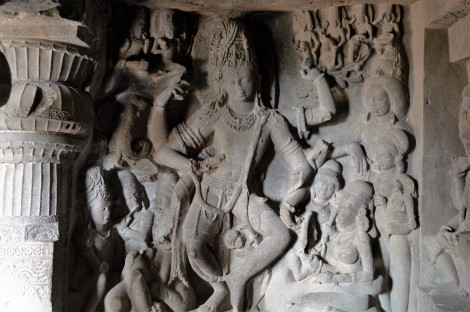Journey to Ellora Caves
I visited Ellora caves during my trip to Aurangabad in Oct 2016 with plan to cover Ajanta, Ellora and Aurangabad during my trip.
I took a MSRTC bus from Aurangabad to reach Ellora and it takes approximately 50 minutes to reach Ellora. The bus drops at a walk able distance in front of cave 16.
Ellora Caves History
Ellora caves, an UNESCO World Heritage site since 1983 are one of the largest rock-cut monastery-temple caves complexes in the world. There are in total 34 caves comprising of 12 Buddhist caves, 17 Hindu caves and 5 Jain caves dating 600 – 1000 AD period.
Unlike Ajanta caves which are dedicated to Buddhism, Ellora caves comprises of Buddhism, Brahmanical and Jain caves temples and one gets an opportunity to see three different styles of architecture at one place . The co-existence of the multi religion cave temples gives impression of the religious tolerance existing at that time. This is reinforced from my experience in Badami caves visit where Hindu and Jain caves coexist.
The Ellora Caves were built under the patronage of the Rashtrakuta kings who succeeded the Chalukyas in 753 AD. Ellora caves emerged on horizon when Buddhism was on a decline in India. It was the same time when Ajanta caves were abandoned and slowly forgotten.
Buddhist caves – Cave 1 – 12 (500-750 AD)
The Buddhist caves are the oldest caves in Ellora.
Cave 1
Cave 1 is monastery (vihara) without any sculptors and appears to be a place for stay and study.
Cave 2
Cave 2 has 12 decorative pillars and comprise of sculptures of Buddha in different postures and various Bodhisatavas.

Buddha preaching with Boddhisatvas
Cave 5
Cave 5 with 24 massive pilars was used by Buddhist monks as assembly hall,dinning room and for performing rituals. The caves comprise of Buddha in preaching posture with two Bodhisattavas.
Cave 10
Cave 10 is a double stored Buddhist monastery comprising of a Chaitya hall. The carved roof reminds the timber construction prevalent at the time.


The highlight of cave 10 is the Viswakarma Cave temple with sitting buddha

Viswakarma cave temple, Ellora
One striking difference in display of Buddha between Ajanta and Ellora is that in Ajanta caves have two deers are always below Buddha sculpture and in Ellora caves two lions are shown below Buddha sculpture.
Brahmanical caves – Cave 13 – 29 (600-870 AD)
Cave 16
Cave 16 features the Kailasha temple, Lord Shiva mountain abode is the largest monolithic excavation in the world carved out of rock and is the masterpiece in all Ellora cave temples. The temple is dedicated to Shiva.The temple was built to display the grandeur of Rashtrakuta dynasty.It is said that it took more than 200 years and 10 generations to build this marvel of architecture.
The main temple was known as “Rang mahal” as the temple was plastered and painted on completion. However, little color and plaster remains visible at few places now due to the passage of time and one can only imagine the grandeur of this place when this temple was completed.
At the entrance of temple, one can see the huge sculptures of Durga and Vishnu on lotus.

Cave 16 fierce Durga sculpture

Cave 16 Vishnu Sculpture
There is a strange sculpture showing one human sitting over two humans depicting survival of the strongest (2nd from the left).

Sculpture showing one human sitting over two humans depicting survival of the strongest
Cave 21
Cave 21 has some of the best sculptures of Ellora on display. It has sculpture of Nandi on a raised platform. The cave temple displays various parts of Shiva life.
Ravana lifting the Kailash : One can see the depction of a mythological story that Ravana under arrogance tried to lift the Kailasha. Shiva simply put down his foot on the floor and Ravana was helplessly trapped.

Cave 21 – Ravana lifting Kailasha

Cave 21 – Shiva – Parvati marriage with Ganesha in the middle

Cave 21 – Shiva playing dice with Parvati

Shiva as Natraj
There is a small scenic waterfall at the end of Cave 29. However, the access road to the waterfall has been closed.

Jain Caves – Cave 30 – 34 (800-1000 AD)
Jain caves are located at a distance of 2 km from Buddhist and Hindu caves. You have to take a bus to reach Jain caves. The same ticket can be used for returning from the caves.
Cave 32
Cave 32 known as Indra Sabha i.e. the assembly hall of king of Gods, Indra. Generally, one rarely finds Indra sculptures.
Sculpture of Indra under a banyan tree and Indrani under a mango tree
Some rare paintings at Cave 34



It took four and half hours to cover Ellora caves and I still had not enough and wanted to spend some more time. However, it was time to say adieu and may be come again sometime soon.







Reblogged this on Third Eye View and commented:
My Ellora trip pics and experience
LikeLike
Extraordinary place.. 🙂
LikeLiked by 1 person
True. One of the best place on cave architecture
LikeLiked by 1 person